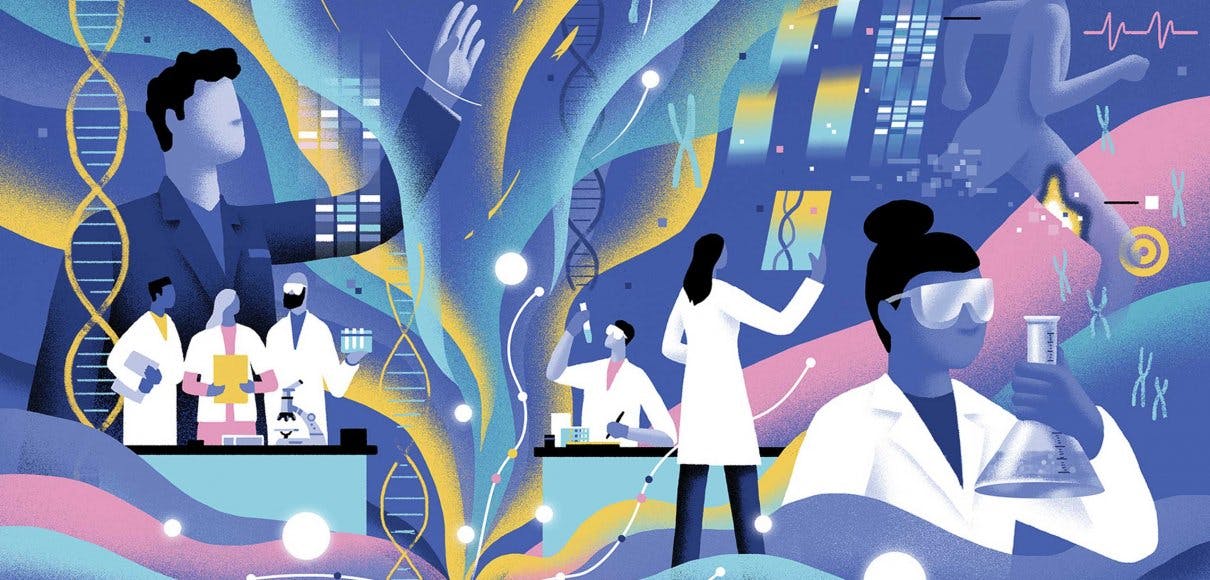EVERY STUDENT who dreams of becoming a researcher imagines making the big discovery: the cure for cancer. More effective treatments for diabetes. A breakthrough for Alzheimer’s disease.
At Seattle Pacific University, undergraduates find themselves on the cutting-edge of microbiology research from the start. Working side by side with their professors, and sometimes in partnership with the University of Washington, these students are making important scientific discoveries — and charting the course of their future careers.
Zoie Bailey ’22 wanted to be a vet when she grew up. She spent years caring for her pets, but she changed her mind in high school when she became interested in human physiology and anatomy.
Bailey wasn’t sure what type of doctor she wanted to be, but she knew she wanted an undergraduate experience where her professors knew her. “My mother and I toured the SPU campus, and we loved it,” she remembered. “I felt drawn to the school.”
Being a freshman in college — away from friends and family for the first time — can be difficult. Add to that a challenging course load, and students can find themselves feeling isolated, Bailey said.
That changed when she learned about SPU’s BioCORE Scholars Program from one of her teaching assistants. The initiative supports students like Bailey who are traditionally underrepresented in biological and biomedical sciences or who may be the first in their families to go to college.
Bailey benefited from having a mentor during her first year at SPU to guide her through the challenges all freshmen face. When she was accepted into the BioCORE program, her research career at SPU began.
A close-knit academic family
Victoria Bowman ’22 knew she wanted to be a doctor after taking a microbiology class during her senior year in high school. “At that time, I was facing some medical issues. Some of the doctors who cared for me were also researchers, and I knew that’s what I wanted to be.”
Bowman, who identifies as a mixed-race Filipina, believes the BioCORE program connected her to a community at SPU. “I chose SPU partly because I wanted to live in Seattle, but I’ve stayed because of the faculty and students I’ve worked with and the BioCORE program.

“Certain messages have been internalized for me throughout my life,” Bowman admitted, “especially the idea that I had to prove myself because I am a woman and a minority. Growing up, I never had scientist role models, let alone women who were scientists or anyone who looked like me. That changed at SPU.”
Bowman and Bailey became fast friends. In the summer of their first year, they participated in a weeklong project with Karisa Pierce, professor of chemistry and chair of the Department of Chemistry and Biochemistry, to study metals in different shellfish and water samples.
“I was nervous working in the lab that first time,” Bailey remembered. “I was scared I would mess up or set something on fire. But that summer, I worked with investigators and other students who looked like me. I grew more confident and capable.”
The experience spurred the women to pursue other research opportunities at SPU.
“The professors at SPU are proactive in ensuring students have opportunities to grow and succeed,” Bowman said. “Without them and the BioCORE Scholars program, I might have left the sciences.”

Immersive class experiences
Derek Wood had one guiding principle in mind when he designed his senior-level molecular biology class at SPU: “I want to put students in the same environment they will find themselves in when they graduate.”
Traditional lab classes assign students a series of exercises that teach a principle. The students do the same things, and the experiments always work. But Derek, a professor in the Biology Department, designed his class to immerse students in authentic research.
“Over 10 weeks, our students work side by side with faculty on real-world projects,” he said. “They design their protocols, do the work, and analyze and present their results.”
And Derek had access to a research project that could help patients around the world.
Mycoplasma genitalium (MG) is a sexually transmitted pathogen. It is present in 4% of the world’s population and up to 40% of sex workers. It was recently identified as a cause of reproductive tract disorders and infertility in women and men. These bacterial infections are inherently resistant
to antibiotics and can last for years in the human body.
“Normally, white blood cells from the immune system recognize and react to foreign substances in the body,” Derek explained. “They attack bacteria like MG and get rid of them, but somehow MG alters its shape and hides. Before we can develop more effective treatments, we need to understand how that process works.”

“Many undergraduate students never have the chance to work with next-generation DNA sequencing or the gene-editing tool CRISPR.” — Derek Wood
That’s where SPU students can make important discoveries. SPU uses next-generation DNA sequencing and provides this expertise in support of projects on MG at the UW.
Derek broke up his class into six different teams. Bailey’s team studied the microbiome of animals infected by MG. The microbiome — the existing community of microorganisms — and the immune system support one another to promote human health. And it’s the microbiome that teaches the immune system to identify and attack viruses. This field of study is one of the hottest in medicine today as investigators are recognizing the microbiome’s role in preventing disease and promoting good health.
Bowman’s team analyzed cell samples collected from MG-infected pigtail macaques, which share many important features with humans. They carefully
isolated DNA from the samples and sequenced it to learn how the microbiome that MG encounters influences its ability to cause disease.
“These students are working on real-world science,” Derek said. “They have access to breakthrough technology and techniques that are changing medicine. It’s an incredible advantage as they start their careers. Many undergraduate students never have the chance to work with next-generation DNA sequencing or the gene-editing tool CRISPR.” Importantly, the data they generate in the classroom has value and is used in applications for federal
grants and published scientific articles.
Derek’s students also present their findings at local and regional conferences, an invaluable experience that prepares them for the life of a physician-scientist. “These students transition from being taught to becoming teachers themselves,” he said.
Presenting your research in front of your peers and faculty is challenging for a new investigator, but Bailey cherished the experience. “When he knew I was nervous, Dr. Wood would tell me, ‘You’re the expert. This is your data. You know it better than anyone else out there.’

“I remember those words every time I do a presentation, and I’m not as nervous anymore.”
Bailey plans to spend a gap year working in a research laboratory while studying for the MCAT, the admission test for medical school. “BioCORE gave me the opportunity to understand what I am passionate about,” she said. “Here, I was able to understand what research is, what it means to be a scientist, and how to build relationships with peers around me.”
Bailey plans to pursue a career as an OB/GYN and as an investigator focused on molecular biology research.
The life of a researcher
Cellular and molecular biology majors at SPU also have the chance to intern at the University of Washington’s Harborview Lab under the direction of Gwen Wood, research assistant professor in the Department of Medicine, Division of Allergy and Infectious Diseases, and Derek’s wife.
“There is an urgency to understanding the immune response to [the pathogen] MG, and it’s incredibly beneficial to me to have these students in my lab.” — Gwen Wood
“There is an urgency to understanding the immune response to [the pathogen] MG, and it’s incredibly beneficial to me to have these students in my lab,” Gwen said. “Undergraduates like Zoie and Victoria bring energy and new ideas to our investigations. They provide invaluable knowledge that advances our work and helps us apply for future funding.”
Sometimes the work isn’t always exciting.
“I’m isolating protein fragments with Dr. [Gwen] Wood to understand how antibodies bind to different regions of an adherence protein,” Bailey said. “It seemed very tedious at first, but it’s taught me to look for ways our protocols might affect our results. This experience will give me an advantage over someone who has never considered how each step influences the next in research.”
Gwen agreed. “Being an investigator is a hard way of life. We’re inventing new techniques that have never been used for MG before. Our protocols will fail and fail again, but if we can conclude an avenue doesn’t work, that’s actually a win.”
Not all experiments fail, however. Bowman joined the Harborview Lab during her sophomore year at SPU, when she began a cloning project to delete a gene that encodes a protein in MG that interacts with antibodies in abnormal ways.
“We’ve been cloning DNA fragments and trying to delete the gene since I started in the lab,” Bowman said. Two year later, during Bowman’s senior year, they were finally able to successfully complete the deletion. “Now we can study what happens to the disease. We believe if you can delete the gene from MG, it will become more susceptible to antibodies.”
Bowman plans to continue her work in the Harborview Lab before applying to graduate school. “I am fascinated with genetics and the bioinformatic aspects of medicine. I hope to become a genetic counselor one day.”
Illustrations by Matt Chinworth




